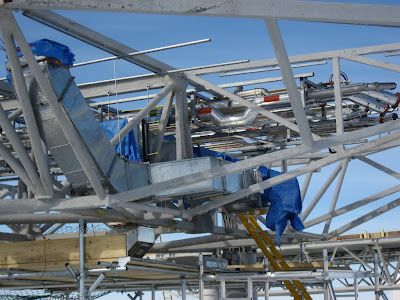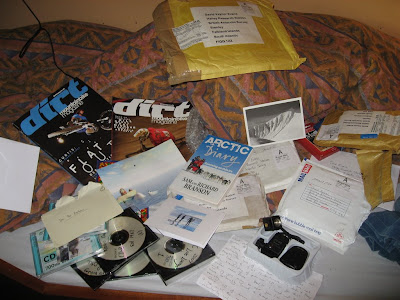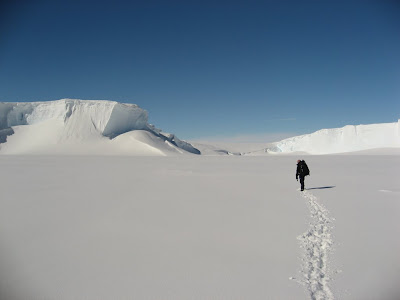Yesterday was great. Just as I was settling into the mundane but somehow satisfying process of compacting waste plastic into bales, Ags came rushing in exclaiming "ah, there you are. We need a co-pilot".
The weather had cleared and a fuel depot needed restocking, so half an hour later I was at the skiway ready to go.
 Chad fueling the aircraft
Chad fueling the aircraftWe heaved and lashed four drums of fuel in the back, then strapped in as Mark corrected his altimeter for air pressure and banged our destination into the GPS. Within a few minutes the engines were warm and we were ready to go.
 Ready for take off!
Ready for take off!Taking off on the groomed skiway was very smooth - The Twin Otter is a Short-Take-Off-&-Landing (STOL) aircraft so gets airborne only motorway speeds, even less is there's a headwind.
Once climbed and on course, Mark asked if I'd like to fly. Trying not to grin like a maniac, I said yes. Being a highly qualified instructor, he gave some brief instructions and then handed over the controls. To get the feel, I turned left, leveled then came back right again, all the time watching the horizon ahead. Next was up and down, watching the Rate of Climb and Air Speed instruments to be sure I wasn't pulling too hard.
 Another school-boy dream comes true!
Another school-boy dream comes true!Although the yoke is connected to the control edges by nothing more than cables, the feel was positive and responsive, requiring little movement to affect our direction. If you can remember a car without power-steering - it felt like that, but in 3D! I was a bit surprised when after 10 minutes, Mark started filling in his paper work. A little while later he looked up, gave a new compass bearing to follow, and tucked into a sandwich!
 The best job on earth
The best job on earthAfter a little over an hour we had covered 125 mile onto the continent itself. As the GPS showed our destination approaching, I handed the controls back and strained my eyes to spot the marker, a single oil drum, against the enormous white backdrop. Suddenly we spotted it and dived into a bumpy but precise landing, coming to rest right on target.
Waiting for the propeller to stop completely - they're right next to the front doors - I stepped down onto "Proper Antarctica". Not just a floating ice shelf, this was the actual continent - although it looked no different at all!
 Mark unloading his aircraft
Mark unloading his aircraft Petrol-Station Diner
Petrol-Station Diner
If we couldn't see any difference, we soon felt it. The aircraft's altimeter showed we'd landed at 5,500ft - enough to feel short of breath when lugging 180kg drums about.
With the drums in place, we opened our flasks for a civilised lunch and chatted about the planes. The Twotter design dates from 1964 with the last being made in 1988. Age is irrelevant as maintenance standards are so high, but even if BAS were to go shopping for a new aircraft there's nothing on the market that can do the job. High capacity, simple and tough, they really are the Transit of the sky. Proven in harsh environments across the world, pilots have a well-founded trust in the aircraft. This trust was tested and proven during a Medevac from the Amundsen-Scott South Pole station in 2001 when a Canadian team flew in temperatures in the -60C - so cold that blow-torches had to be used to light drums of aviation fuel to illuminate the runway in the winter night!
I've always admired them form afar, but having been up-front I can now really appreciate why the little red planes are so special.
 20-something years old and still lookin' good
20-something years old and still lookin' goodOn the way home I swapped seats to let Les, the incoming plumber, have a play. Although he'd had a full RAF trade career, he was still as delighted as me to have a fly.
 Mark (L) shows Les (R) the controls
Mark (L) shows Les (R) the controlsSitting in the back, I got to admire the spectacular crevassed Hinge Zone (which we visited back in March) from above. It was humbling to think how 40 years ago lives were lost trying to force a route through the crevassed maze, and we had just leap-frogged many years' work in a relatively safe hour and a bit.
 The crevassed maze of the Hinge Zone
The crevassed maze of the Hinge ZonePassing over the spectacular area, Mark took the controls once more to give us a closer view. Although the cowboy days of leaving ski-marks on mountaintops are long gone, these guys can really fly.
 Turning for a better view
Turning for a better viewSight-seeing done, we headed back in via the Halley VI site, where the remote construction camp is now up and running.
 Halley VI site
Halley VI siteFrom the air you can see how much the old base has changed. Three 1km long cargo lines stretch northwards with the main construction taking pace in the prop-blur, just to the right of the building cluster.
We landed smoothly, taxied in and climbed down with massive thanks and big grins. These little toppings make staying on well worth it.
Videos coming soon. More on the cracking little Twin Otters
here.






























































